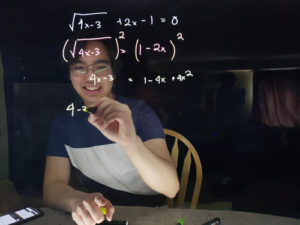Trinity Western University (TWU) students bring more human faces to online learning by building lightboards that allow professors to look directly into the camera while drawing and illustrating on lighted glass.
Through a matching grant from ECO Canada, Trinity Western hired two Computing Science students to build lightboards – a glass “chalkboard” that is fully lighted and transparent, useful for lecture recording and remote teaching.
Related content: 6 tips to reopen universities during COVID-19
Students Jacob Pettigrew (BSc Computing Science, 2021) and Dave Garcia (BSc Computing Science, 2024) began their work on July 20. They are committed to building two lightboards–and more–if they are able.
The human element of online learning
Pettigrew hopes to help other students succeed in their studies this fall. “I am excited about building the lightboards because I believe that the transition to online school in the fall will be difficult for many people, and the use of lightboards can make this transition easier,” he said.
“Lightboards add a human element to online learning, as the instructor can interact with the students by looking directly into the camera while drawing and illustrating points on the lightboards,” he says.
Garcia adds, “As a student, I’m excited to interact with my professor instead of looking at a slide with texts.” With the lightboards, Garcia anticipates improved engagement between professors and their students, which will motivate students to learn.
“I hope that our work will improve the quality of life and atmosphere in our online classes for both students and professors,” Garcia says. “And lastly, I hope that the familiarity the lightboard offers will alleviate the stress that professors may have when shifting from a physical classroom to an online one.”
The team recently completed their first prototype and are now in the process of debugging. “We are still working out some of the details, but it seems to be working well,” says Dr. Herbert Tsang, TWU Computing Science professor and the project’s lead.
Building a lightboard for a fraction of the cost
A commercial table top lightboard can cost $2,000, while a complete lightboard and recording system can cost up to $12,000.
Dr. Tsang and his students spent less than $200 on the cost of supplies for building their lightboard, and the university’s I.T. Department is prepared to support professors with recording equipment and training as well.
Improving teaching technologies
In addition to helping students, Dr. Tsang hopes to help his colleagues to deliver high-quality instruction by providing them with technological teaching tools – resources that are especially valuable in today’s remote learning contexts.
“We hope to make a contribution for TWU’s success in delivering online education,” he says.
A lightboard is especially useful for recording video lectures and for online teaching, modes of education that are increasingly prevalent in the time of COVID-19.
For professors, lightboards provide a larger surface to write in a more natural manner. In this way, they are not limited to using pre-made slides and presentations, or to digital writing platforms.
For students, the lightboard allows them to watch the instructor’s face, as she writes and lectures, and not only her back.
Furthermore, the set-up for a lightboard is relatively straightforward and can be done at home. The lightboard has built-in LED lights that simply need to be plugged in to a power source for use.
Innovation in higher education
Dr. Tsang remarks, “Delivering education online requires good tools and pedagogical skills. It is not just videotaping everything and putting it online.”
Trinity Western is ready to help students access a high quality education this fall, regardless of where students are geographically. The TWU Access experience provides students with a full educational package of community, connection, mentorship and learning.
HOW TO BUILD A LIGHTBOARD:
Materials needed:
– Plexiglass
– Steel spring clamps
– Wood beams for frame
– LED light strip (white)
– Black cloth for backdrop
– L-shaped brackets to hold lightboard
How to assemble a lightboard:
1. Set up a dark background, for example, by hanging a dark cloth on the wall.
2. Build a wood frame around the plexiglass.
3. Assemble the LED light strips onto the plexiglass.
How to record with a lightboard:
1. When recording, position the lightboard between the presenter and the camera.
2. Write on the glass surface with fluorescent markers for easier readability. Make sure that the text and the presenter remain visible to the viewer throughout the recording process.
3. When editing the video, flip the image orientation so that the text is readable for the viewer.
- Survey: More students want to go to graduate school - April 24, 2024
- Educause, AWS launch generative AI readiness assessment tool for higher ed - April 23, 2024
- A bungled FAFSA rollout threatens students’ college ambitions - April 19, 2024

